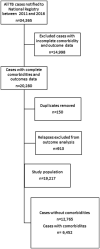The impact of comorbidities on tuberculosis treatment outcomes in Poland: a national cohort study
- PMID: 37732096
- PMCID: PMC10508909
- DOI: 10.3389/fpubh.2023.1253615
The impact of comorbidities on tuberculosis treatment outcomes in Poland: a national cohort study
Abstract
Background: Tuberculosis (TB) is a complex disease associated with other medical conditions, that may affect disease severity. This study aimed to investigate the impact of comorbidities on treatment outcomes and mortality rates in patients with TB in Poland.
Methods: We analyzed a national cohort of 19,217 adult TB patients diagnosed between 2011 and 2016 in Poland. We compared treatment success rates and mortality rates in patients with comorbidities and those without to assess the impact of various comorbidities on these outcomes. Odds ratios (OR) were calculated to quantify the association between comorbidities and TB treatment outcomes.
Results: Patients with comorbidities had lower treatment success rates and higher mortality rates. Diabetes was identified as a significant risk factor for increased TB mortality (OR = 1.9) and mortality from all other causes (OR = 4.5). Similar associations were found for alcoholism (OR = 8.3 and OR = 7.1), immunosuppressive therapy (OR = 5.7 and OR = 5.9), and cancer (OR = 3.4 and OR = 15.4). HIV and tobacco use were associated with an increased risk of mortality from causes other than TB, with odds ratios of 28.6 and 2.2, respectively. The overall treatment success rate in the study population was 88.0%, with 9.2% of patients failing to achieve treatment success and 2.8% dying. Comorbidities such as diabetes, alcoholism, substance addiction, immunosuppressive therapy, cancer, and tobacco use increased the risk of tuberculosis treatment failure.
Conclusion: Patients with comorbidities face a higher risk of unsuccessful treatment outcomes and increased mortality. It is essential to implement integrated management strategies that address both TB and comorbid conditions to improve treatment success rates and reduce mortality.
Keywords: Poland; comorbidity; mortality; treatment outcome; tuberculosis.
Copyright © 2023 Nowiński, Wesołowski and Korzeniewska-Koseła.
Conflict of interest statement
The authors declare that the research was conducted in the absence of any commercial or financial relationships that could be construed as a potential conflict of interest.
Figures








Similar articles
-
Alcoholism and other socio-demographic risk factors for adverse TB-drug reactions and unsuccessful tuberculosis treatment - data from ten years' observation at the Regional Centre of Pulmonology, Bydgoszcz, Poland.Med Sci Monit. 2014 Mar 19;20:444-53. doi: 10.12659/MSM.890012. Med Sci Monit. 2014. PMID: 24643127 Free PMC article.
-
Tuberculosis in Poland in 2017.Przegl Epidemiol. 2019;73(2):211-226. Przegl Epidemiol. 2019. PMID: 31385679
-
Tuberculosis in Poland in 2018.Przegl Epidemiol. 2020;74(2):239-257. doi: 10.32394/pe.74.19. Przegl Epidemiol. 2020. PMID: 33112107
-
Tuberculosis.In: Holmes KK, Bertozzi S, Bloom BR, Jha P, editors. Major Infectious Diseases. 3rd edition. Washington (DC): The International Bank for Reconstruction and Development / The World Bank; 2017 Nov 3. Chapter 11. In: Holmes KK, Bertozzi S, Bloom BR, Jha P, editors. Major Infectious Diseases. 3rd edition. Washington (DC): The International Bank for Reconstruction and Development / The World Bank; 2017 Nov 3. Chapter 11. PMID: 30212088 Free Books & Documents. Review.
-
Effect of HIV status and antiretroviral treatment on treatment outcomes of tuberculosis patients in a rural primary healthcare clinic in South Africa.PLoS One. 2022 Oct 12;17(10):e0274549. doi: 10.1371/journal.pone.0274549. eCollection 2022. PLoS One. 2022. PMID: 36223365 Free PMC article. Review.
Cited by
-
PPARdelta: A key modulator in the pathogenesis of diabetes mellitus and Mycobacterium tuberculosis co-morbidity.iScience. 2024 May 22;27(7):110046. doi: 10.1016/j.isci.2024.110046. eCollection 2024 Jul 19. iScience. 2024. PMID: 38989454 Free PMC article.
-
Factors related to self-care in Korean patients with tuberculosis: A systematic review and meta-analysis.Medicine (Baltimore). 2024 Sep 27;103(39):e39920. doi: 10.1097/MD.0000000000039920. Medicine (Baltimore). 2024. PMID: 39331886 Free PMC article.
-
Non-communicable comorbidities in pulmonary tuberculosis and healthcare utilization: a cross-sectional study of 2021 Indonesian national health insurance data.Arch Public Health. 2024 Aug 19;82(1):127. doi: 10.1186/s13690-024-01352-y. Arch Public Health. 2024. PMID: 39160626 Free PMC article.
References
-
- Global tuberculosis report 2022 [internet]. Available at: https://www.who.int/teams/global-tuberculosis-programme/tb-reports/globa... (Accessed 5 June, 2023).
-
- Maria Korzeniewska-Koseła . Gruźlica i choroby układu oddechowego w Polsce w 2021 r. Warszawa: Instytut Gruźlicy I Chorób Płuc; (2022) isbn:978-83-928021-8-1.
-
- The end TB strategy [internet]. Available at: https://www.who.int/teams/global-tuberculosis-programme/the-end-tb-strategy (Accessed 5 June 2023).
Publication types
MeSH terms
LinkOut - more resources
Full Text Sources
Medical

